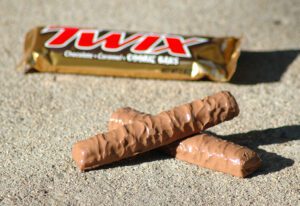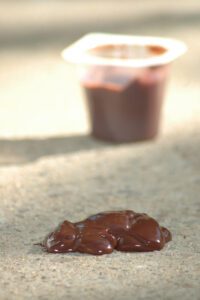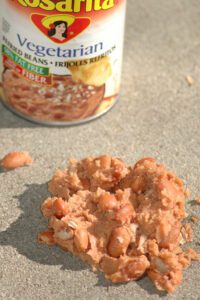You can learn a lot about your dogs’ health from their poop. Its color, consistency, contents, odor, amount, and frequency can give you valuable, up-to-date information about their health. For example, it can provide early warning that your dog’s diet may be unsuitable, or that she may be grappling with parasites, viruses, unfriendly bacteria, bad water, emotional upset, food allergies, or serious illness.
So try to check it out every day. Don’t be shy! You might use a twig to poke it apart, although picking it up carefully with a bag or scooper may yield a similar opportunity to observe its qualities. This way, you’ll come to know whether your dog’s poop seems right or wrong, and when you need to do something about it.
Anytime you are not sure of what you’re seeing, check with a vet, an expert in canine nutrition, or your reliable home library. Those specialty pet supply shops that actively promote the raw diet and sell ingredients for it often have staff who are very well-informed. But there’s no getting away from it – competent doggy-doo divination begins at home. And to recognize a problematic poop, we must start with a concept of the ideal excrement.
The perfect poop
A dog’s feces varies somewhat according to whether he eats kibble, canned, or home-prepared food. But all well-formed dog poo shares certain characteristics. First, healthy stool should have a relatively inoffensive odor. For another, it will typically be brown and of an even, well-digested consistency.
Pet food industry professionals use a scale of 1 to 5 to rate poop quality. Usually, 1 means liquid diarrhea, whereas 5 indicates a hard and dry stool. The industry generally agrees that 4 is ideal, says Claudia A. Kirk, DVM, PhD, Dipl. ACVN and ACVIM. Dr. Kirk, an associate professor of medicine and nutrition in the Department of Small Animal Clinical Sciences at the College of Veterinary Medicine, University of Tennessee, describes the perfect 4 as “a light- to dark-brown stool that is well-formed, firm but malleable, moist, and does not fall apart when picked up.”
Understand that every dog has her own version of “normal.” To be able to distinguish the good from the bad, you need to know your own dog’s poop when she’s absolutely radiant with good health!

Feces facts
Poop is the by-product of the digestive process. Food is broken down into basic molecules in the stomach and small intestine, enabling the small intestine to absorb them. Enzymes break down proteins into amino acids, carbohydrates into sugar molecules, and fat into cholesterol and di- and tri-glyceride components.
Food particles not absorbed by the small intestine pass into the large intestine (the colon), along with gut secretions, pancreatic enzymes, bile salts, discarded intestinal cells, mucus, intestinal bacteria, secreted water, minerals, and vitamins. This substance is typically green and soupy.
The party is not yet over when this matter (known as the “ingesta”) reaches the colon, which absorbs much of the water, many minerals, some vitamins, and most bile salts. Any food that is still undigested provides nutrients for the normal microbes that live in the lower gut. Fermentation of these nutrients occurs there, producing volatile (and often smelly) gases, altering the pH of the colon, and even changing some of the food into short chain fatty acids, which are very important for the health of the colonic epithelial cells (colonocytes).
Fermentation is a normal part of digestion; it produces essential vitamins such as vitamin K. Vitamins, short chain fatty acids, certain minerals, and bile acids are absorbed across the colon along with large amounts of water. As the “leftovers” move toward the rectum, removal of the water concentrates the ingesta into what we know as feces.
By the time it comes out of the dog, poop is made up of unabsorbed nutrients, cells, bile pigments, volatile fatty acids and organic compounds, mucus, water, electrolytes, and additional metabolic waste products.
Factors affecting stool quality
How wonderful it would be if we could catalog wayward types of feces and simply cross-reference them to find out whether a dog needs a new diet, more exercise, a particular remedy, or a medical procedure!
Unfortunately, poop defies neat and tidy classification. Problem poop can give us a helpful heads-up about a dog’s possible ill health, but taken as a sign by itself “it can rarely pinpoint the cause or severity of the problem, since there is huge overlap across the disorders,” states Dr. Kirk.
All kinds of things can upset the digestive system, including food with low digestibility, an out-of-balance bacterial population, intestinal disease, toxins, pharmaceuticals, botanicals (herbs), vitamin supplements, nutritional oils, nutraceuticals, food allergy or intolerance, vaccinations, exercise, and emotional stress.
How can we tell the difference between feces affected by what a dog ingests as opposed to those reflecting the presence of viruses, bacterial infections, parasites, systemic or organ disease or failure? “Unfortunately, (the latter) will look just like poop from dietary indiscretion, food allergies, and so forth,” Dr. Kirk says. So we need to look at all of these different factors.
-
- Food digestibility
The amount of food molecules entering the colon depends on a variety of factors. One is the dog’s ability to digest an otherwise satisfactory meal. Another is the inherent digestibility of the food provided. If the diet is digestible, fewer molecules end up in the colon and fermentation is minimal. But when lots of undigested nutrients enter the lower small intestine and colon, fermentation can be profuse.
Whereas the colon normally extracts water from digested food, changing it from liquid into something solid and well-formed, the production of large amounts of gas and short chain fatty acids, when severe, will draw water back into the colon. “This is the same process that occurs in people with lactose intolerance – producing gas, diarrhea, and flatulence,” Dr. Kirk explains.
Doggy diets vary considerably concerning contents, combinations of foodstuffs, and degrees of processing. Nevertheless, Dr. Kirk offers a few generalizations about some common pet food ingredients that can affect stool quality.
Fibers constitute an important component of the diet. Some are fermentable and others are not. The type, amount, water solubility, water holding capacity, and fermentation rate of a fiber source significantly affects stool quality.
However, opinions differ about good sources of fiber for dogs. Dr. Karr-Lilienthal, companion animal specialist and lecturer in Companion Animal Science at the University of Nebraska in Lincoln, recommends oats, carrots, and brassica vegetables such as broccoli. She likes beet pulp, since about half ferments in the gut, where it’s easily broken down by friendly bacteria, and because the indigestible half improves the stool quality.
Jennifer Lennon, founder of Healthy Paws, a Toronto company that produces raw diets for dogs and cats, favors ground whole black oil sunflower seeds, including the hulls; ground whole veggies, particularly roots such as beets and carrots; and ground whole pumpkin seeds.
Corn often gets blamed for causing voluminous, gloppy stools. However, Dr. Karr-Lilienthal believes that the story is a little more complicated. “Corn has a bad reputation partly because it’s a fairly common food allergen,” she says. She believes that while corn offers some nutritive bene-fits when used to provide fiber, a problem arises when pet food companies use corn – or other cereal grains – as a primary source of protein.
On this basis, she says there’s a positive correlation between the amount we pay for our dogs’ nutrition and its quality. The cheapest foods, such as generic store-brands and others, are usually formulated with inexpensive plant-derived proteins; their fiber sources may be low-cost wheat middlings or peanut hulls. The nutrients in foodstuffs like these aren’t readily available to the animal, she warns.
“It’s actually more cost-effective to feed a more expensive, higher quality diet. You have to feed a lot more of those really cheap foods to get the right amount of nutrients into your animal. As a result, more comes out the other end that they’re not able to utilize. Sometimes those animals are more gassy, too, because of the poorly digested proteins reaching the large intestine – a lot of odor comes from that.”
But not all plant proteins create the same problems. Soy is highly digestible; its issue (besides being another common allergen) is that its carbohydrates are too fermentable and can cause flatulence. Dr. Karr-Lilienthal believes that dogs need a minimum of 4 percent good quality fiber; most pet foods provide a range of 4 to 10 percent. A raw diet that regularly includes ground whole vegetable matter will more than meet this requirement.
-
- Bacterial population
The bacteria that inhabit a dog’s gut play an important role in her food’s digestion and fermentation. The balance of intestinal bacteria is affected by both diet and drugs such as antibiotics.
Over time, intestinal bacteria adapt as much as they can to what the individual dog eats. A dog who dines on the same brand and type of commercial food daily will normally adapt to that diet and produce consistent stools.
In contrast, the poop of dogs who regularly consume a variety of foods, as those who feast on raw victuals usually do, tells a somewhat different story. The stool quality of such a dog usually falls within a consistent range of what’s normal for that individual. In either case, changing the diet too quickly or adding something new can cause bacterial overgrowth and excessive fermentation, resulting in diarrhea. This is why it’s important to allow a dog time to adjust to new ingredients in the diet, or to new brands or types of commercial foods.
-
- Intestinal disease
Any disease that affects the intestine, whether caused by parasites, malabsorption, ulcers, tumors, food allergies, bacteria, viruses, or other culprits, can contribute to vomiting and altered stool.
-
- Toxins
Toxins can come from many sources. Normal foods, plants, excess bile salts, metabolic by-products, and even the dog’s own bacteria can produce them. Toxins can block absorption, alter motility, destroy normal intestinal cells needed for digestion, and stimulate cells to secrete excess water and electrolytes, all of which can create problem poop.
Keep in mind that any time your dog has a persistently abnormal stool, seek professional advice early.
-
- Pharmaceuticals
Anything that upsets the tummy can affect stool quality. Chemotherapeutic drugs and laxatives (obviously!) are good examples. Antibiotics commonly disrupt the normal intestinal bacterial population, producing side effects such as diarrhea. Opioids often cause constipation. Medications containing iron may cause constipation and darken the stool.
There are too many examples to list here. Always find out about the possible unintended effects of any drug before you give it to your dog!
-
- Botanicals (herbs)
Again, the possibilities are many. Some herbs may cause toxicity in an individual animal depending upon the dosage and other factors. Others, like nettle, alfalfa, or flaxseed, may cause digestive upset (and dermatological reactions) if given in large quantities. As with drugs, learn all you can before using any herb, and administer it responsibly.
-
- Vitamin supplements
Supplemented in appropriate amounts, vitamins shouldn’t cause a problem. However, Wendell O. Belfield, DVM, and others following his lead recommend using the sodium ascorbate or calcium ascorbate form of vitamin C. This is because the ascorbic acid form is hard on some dogs’ stomachs. Oil-based vitamins, such as E and A, may soften stools as oils tend to do. Large doses of B vitamins may cause stomach upset and vomiting or, less commonly, diarrhea.
-
- Nutritional oils
Large amounts of oils (for example, flax, fish, corn, and others) will cause greasy stools and possibly diarrhea if added too quickly or if given in excess. Introduce them gradually to your dog’s diet.
-
- Nutraceuticals
Some will cause diarrhea. MSM, ursodiol, SAM-e, and chondroitin sulfates have reportedly caused GI upset in some dogs. Again, introducing them slowly may help.
-
- Food allergy or intolerance
Food allergy or intolerance can cause intermittent to frequent vomiting, diarrhea, weight loss, loss of appetite, itchy skin or ears, eosiniphilic plaques, and a number of less common disorders. Feces quality can range from normal to diarrhea and with or without mucus or blood, depending on the severity of the allergy and what part of the intestinal tract is most affected. Stools will often be lighter in color, and diarrhea obvious, but not always.
-
- Vaccination
According to Dr. Kirk, a dog should not normally have a stool change immediately following vaccination; a reaction may indicate an allergic reaction to the vaccine. This would usually produce diarrhea that may or may not include mucus or blood, and (or) vomiting, vasculitis, and hives. She states that vaccines for leptospirosis and rabies are most commonly associated with this kind of reaction. Note that allergic reactions and vaccine anaphylaxis have many other clinical signs, including acute respiratory distress and death – or, later, immune-mediated phenomena such as thrombocytopenia or anemia. If you observe any change that makes you suspicious of an allergic reaction following any vaccination, inform your vet right away. Subsequent exposures tend to get worse and could result in death.
-
- Exercise
Dogs need regular exercise for their digestive health. Not enough physical activity can encourage constipation, as it does in people. But suddenly increasing a dog’s exercise level can cause diarrhea and lead to dehydration, according to Dr. Karr-Lilienthal, “because it really stresses the animal out (physically). Instead, slowly build their condition.”
-
- Emotional stress
Never underestimate the effects of emotional stress on a dog’s well-being and digestive processes, no matter what her age. As Dr. Karr-Lilienthal says, “Anytime a dog is stressed he’s more likely to have diarrhea. Dogs are very emotional creatures!”
Common dung disorders and how to treat them
There is also quite a long list of the ways in which a dog’s poop can diverge from a normal appearance and consistency. While treatment for these conditions will vary based on the individual and the severity and duration of the abnormal poo, the following are some generalized descriptions and treatment recommendations.

-
- Diarrhea and loose stool
Diarrhea is the most common sign of digestive disturbance. While it’s often of little concern, it can be serious. Diarrhea’s causes are almost infinite, including infections, an ill-suited diet (one containing ingredients that the dog is allergic to or intolerant of), emotional upset, ingestion of toxic or bacterial-laden substances, worms, and many more. A lot of dogs can’t digest the lactose in milk products and get diarrhea from that.
Diarrhea results when things move along too quickly for the colon to extract enough water for the stool to take form. If it occurs only once or twice and then resolves itself, the dog’s body was probably clearing itself of material that was inappropriate, irritating, or teeming with unfriendly bacteria.
However, you’ll need to be concerned when diarrhea is severe, contains or smells of blood, contains raspberry-jam like mucus, is accompanied by other signs of illness, or continues for more than a couple of days. In these cases, it could be telling you either that the diet is wrong for the dog or that the dog may be – perhaps urgently – ill. Even in less dramatic cases, dehydration is always a danger with diarrhea; and chronic diarrhea can lead to malabsorption and long-term degradation of health.
In general, if diarrhea appears simple and uncomplicated with no other symptoms, wait a day or two. Provide plenty of water! Give your dog’s immune system a chance to do its work. Think about what she might have gotten into that she shouldn’t have. If the diarrhea doesn’t clear up, start looking to either the diet or illness for answers.
Consult with a vet anytime you see additional symptoms, after two days with no improvement, or immediately if your young puppy has the runs.
- Constipation and dry stool
Possible causes for constipation include feeding a very high-fiber diet to a dog who doesn’t drink enough water to hydrate the fiber; lots of bone meal in the diet; iron supplements; opioid drugs, or consumption of indigestible items like wool, hair, plant material, rocks, or kitty litter. Lack of exercise, obesity, diseases that decrease water intake or increase output (such as diabetes, renal disease, liver problems, etc.), and hypothyroidism can all cause constipation.
More possible causes of constipation include neoplasia (growths) in the GI tract, motility disorders, and abnormal anatomy. Anatomic issues such as a broken pelvis, narrow pelvic canal, rectal or anal strictures, perineal hernias, and an enlarged prostate can constipate a dog. Any pain, including postural, can discourage a dog from defecating. A dog locked in the house all day may also become constipated from holding onto feces too long.
Ideally, every dog should have available a source of fresh water at all times. This is true even for dogs who eat raw diets and canned foods, which contain lots of moisture. However, if you’re gone all day or if you crate your dog (and especially if you feed dry kibble), provide water in the morning and assure unrestricted access to it in the evening and at night, so that he can drink until satisfied.
See if you can arrange things so that your dog is not alone and indoors all day. Old dogs, especially, need enough fiber in their food and a predictable routine to support their regularity.
For constipation, well-known animal herbalists Mary Wulff-Tilford and Greg Tilford suggest offering organic, live-cultured yogurt. If the dog is straining, they recommend ground flaxseed, psyllium husk, or marshmallow root to lubricate the intestines; give 1/4 tsp. of any of these herbs for each 20 pounds of body weight plus lots of water. Fresh chickweed may also help.
If constipation is chronic, reevaluate what you’re feeding your dog. If the digestive system has suffered long-term damage, you’ll need to do further research for more lasting solutions. Thoroughly check out the safety of any herb or drug you consider giving to a pregnant animal.
Should people give their dogs human-style laxatives for constipation, or drugs for diarrhea? “Not without your veterinarian’s input and instructions for appropriate dose,” cautions Dr. Kirk, because:
1) Some of the most familiar drugs for humans are toxic in dogs and cats. For example, the common painkiller Tylenol can cause acute liver failure in both animals.
2) Some medications may contain other drugs that pets shouldn’t have, but they are listed in a form that owners would not recognize.
3) Determining the correct dose for a dog is more complicated than it appears. One does not necessarily scale up and down drug doses on the basis of weight alone. On top of that, there are species differences in tolerance and doses. “So while Kaopectate, Lomotile, and Pepto-Bismol can be used under certain circumstances,” Dr. Kirk says, “check with your vet first to make sure of the correct dose, and that the drug does not interact with other disease conditions or medications the pet may be taking.”
4) Over-the-counter human drugs are designed to be used for 1 to 2 days, often following a dietary indiscretion. Long-term use is not advocated.
From a holistic view, it’s far better to look for and deal with the cause of poor stool quality or digestive unpleasantness instead of using a drug to control or prevent symptoms. For short-term disturbances, such as uncomplicated constipation or diarrhea, fasting is often the best answer.
Dr. Kirk advises, “For dogs with dietary indiscretion, a 24-hour fast with only clear liquids, followed by slow reintroduction of the normal food, or starting with a bland diet such as cottage cheese and rice, or giving a therapeutic intestinal diet, works better than drugs.” A number of holistic dog care books describe how to fast a dog safely, reintroduce foods afterward, and create natural therapeutic intestinal diets.
-
- Straining
Anything that causes constipation could cause straining, plus any inflammation of the colon, rectum, or perianal region. Also seen with lower urinary tract disease. You must figure out whether the straining is related to defecation or urination, as urinary obstruction can be rapidly fatal.
-
- Poop that is flat on one side
An enlarged prostate can press against a male dog’s rectum, causing him to strain and then pass a stool that appears flat on one side due to squeezing past the obstacle. It may also have a squishy or mushy consistency, for the same reason. If you see one-side-flattened feces, have your dog’s prostate checked.
- Greasy feces
A sign that your dog is not digesting the fat in his food. If it continues, look into possible causes of malabsorption, including pancreatic trouble, parasites, or others.
- Extremely stinky
Excessively stinky stools can occur for a variety of reasons. In Dr. Kirk’s experience, high meat diets typically produce the worst odor due to the skatols and sulfides produced during meat breakdown.
-
- In contrast, Lennon has found that with appropriate raw fare, dog poop frequently has almost no odor at all. As with most other aspects of stool quality, a healthy dog on raw rations may exude a wider array of aromas in her feces than a dog on processed fare, but Lennon has seen dogs on processed food whose stinky poop has become perfectly pleasant after switching to raw comestibles. Again, the suitability of the diet to the dog and the degree to which the dog has adjusted to the diet will play a crucial role in the olfactory aspect of doggy-do.
In any case, feces should never smell alarming; a scent of blood or severe rancidity should alert you to something amiss. Beans and some cruciferous vegetables may cause flatulence, due to certain starches that break down poorly in the intestinal tract. Food allergies or sensitivities can result in smelly gas and stool, too. Intestinal parasites, such as Giardia, create their own end-products that also smell. Viruses, such as canine distemper, have a specific effect on the GI tract, as well. Both are examples of conditions that produce distinctive, identifiable stool odors.
-
- Odd contents
Poop may at times contain indigestible food chunks such as raw carrot, whole nuts, or unchewed (whole) seeds. Grass is also common; dogs eat it for many reasons, one of which is to help them clear out troublesome matter from their digestive tract. However, nonfood items such as bits of plastic, wood, or other intriguing things can cause a blockage or other problems. If their appearance is only occasional, you probably don’t need to be concerned. Do, though, look for ways to stop your dog’s access to nonfood “extras.”

-
- Hair
Dr. Karr-Lilienthal points out that when a dog’s poop contains significant quantities of his own hair, it can indicate a problem – but one involving the skin, rather than the digestive system! If you see a lot of hair, think: possible allergies, fleas, or insufficient grooming – by you or by the dog!
-
- Mucus
Mucus means an irritated colon. The trouble can range from mild to severe, and is caused by common culprits – “wrong” bacteria, parasites, viruses, sticks passing through, etc. If it doesn’t clear up after a bowel movement or two, you’ll need to figure out what’s up.
-
- Absence of stool
If she otherwise seems perfectly fine, don’t worry if your dog occasionally fails to defecate for a day or two. But if she hasn’t passed any stool or gas for a couple of days, or is vomiting, dehydrated, and/or her abdomen feels tender and hard, she may have an intestinal blockage. If blockage is total, your dog will need immediate surgical intervention, as this condition quickly becomes life-threatening.
Signs of partial blockage include slightly bloody or watery brown feces, which may indicate that the intestine has telescoped in on itself. Swallowed objects that can block the intestines include stones, bones, toys, or, according to Dr. Karr-Lilienthal, chunks of hard chew items such as “Greenies.” By the time you notice it, the damage caused by blockage may already be quite severe.
- Odd colors
When everything’s in balance, look for a range of light to dark browns – anything from ocher to mahogany. A complex mix of healthy digestive secretions color feces this way. Stool produced by a dog on a raw diet will vary more in hue than will that from commercial food. Be aware that dyes used in some foods or treats can stain feces almost any color. Fresh-ground raw beets may innocently stain poop a deep red that can look (and ooze) almost like blood, whereas commercial diets that contain beet pulp probably won’t have the same effect.
Yellow, hard stool often results from a diet that contains a lot of bone meal. Soft yellow stool can indicate a serious problem like a viral infection, especially if it’s yellow diarrhea, with or without vomiting.
Green may not always mean there’s something wrong, but it can indicate imbalances. These may be momentary and caused by something recently eaten, or reflect longer-term problems such as parasites or an organ issue.
White or very pale and hard. This is often produced by dogs on a raw diet containing bone meal. It may appear in one feces but not in another on the same day. It may be slightly difficult for the animal to pass, as it can be comparatively hard, but is not usually a cause for concern.
The addition to the diet of good quality vegetable fiber can help to ease the situation. Some raw food advocates maintain that harder solids such as bone meal or undigested bits of carrot in the stool help keep dogs’ anal glands healthy by stimulating them to express as the poop passes by.
Bloody (red). This is an emergency situation. It could have been caused by the dog having swallowed something that’s causing damage in the GI tract, or by a severe food allergy. It can also signify other problems, such as cancer. Frank red blood or mucus that looks like raspberry jam can indicate life-threatening disease. When you see bloody stool, have your dog seen by your vet right away.
Black or tarry. Tarry or black stool, possibly resembling coffee grounds, may signify bleeding from the stomach or from high in the small intestine. Blood from high in the GI tract gets digested on its way through, which is why it comes out black. This is obviously an emergency. However, a meal of raw organ meats, such as brain or spleen, may also produce black feces in healthy dogs. Dr. Kirk adds that Pepto-Bismol can cause very dark stool. If you don’t know why your dog’s stool is black, get qualified help, quickly.
Poop proud
So, dig in and get a load of what you can learn from your dog’s poop. What it has to tell you could save your dog’s life, and will certainly give you guidance about how to best support his health. And don’t feel too self-conscious! Most likely, the only one who will stare at you while you’re scrutinizing what he left behind is your dog, himself. While he might find your sudden interest a bit curious, he won’t think it’s weird. After all, poop is one of his favorite subjects. Don’t you care more about his opinion – and his well-being – than what anyone else thinks?





